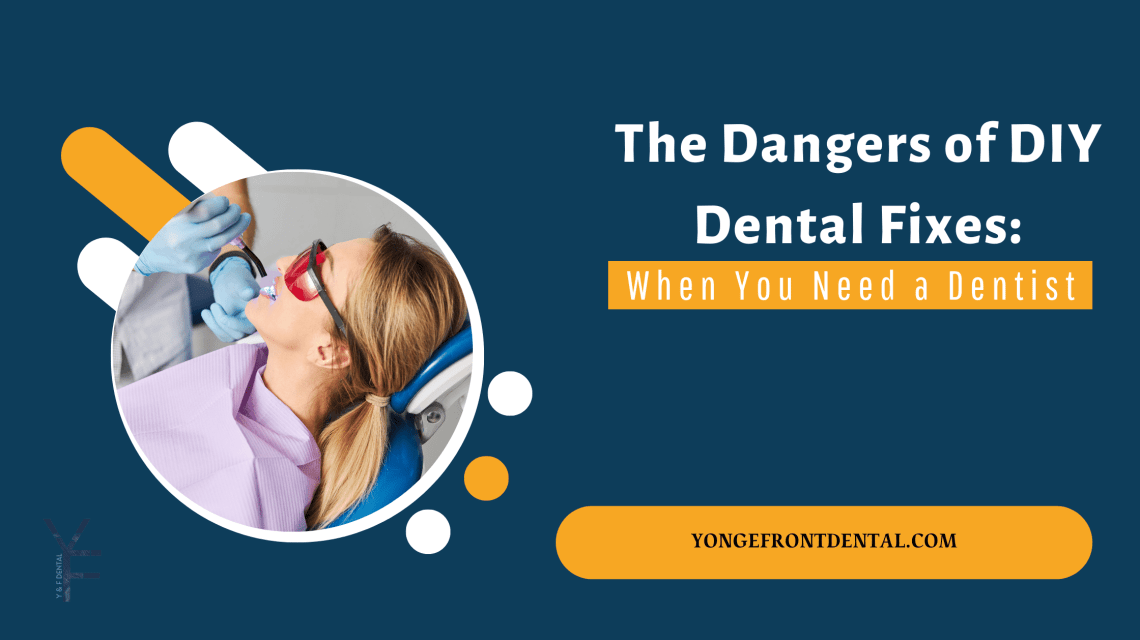Over the past few years, do-it-yourself (DIY) dental treatments have gained popularity, especially through social media platforms. Many people attempt at-home solutions to fix dental issues, hoping to avoid the cost and inconvenience of professional dental care. Videos demonstrating quick hacks for whitening teeth, filling cavities, or even creating makeshift braces have gone viral, encouraging viewers to try these methods themselves.
While some home remedies may seem harmless, many DIY dental fixes can lead to serious consequences. The mouth is a delicate and complex system, and improper treatments can cause infections, permanent damage, and even tooth loss. Understanding the risks of self-treating dental issues is crucial for maintaining long-term oral health.
In this article, we will explore common DIY dental practices, the dangers they pose, and when it’s essential to seek help from a licensed dentist.
Common DIY Dental Fixes & Their Risks
Many people turn to at-home solutions out of desperation, misinformation, or an attempt to save money. While some home remedies, such as saltwater rinses for minor gum irritation, are generally safe, others can lead to serious harm. Here are some of the most common DIY dental fixes and their associated risks:
1. DIY Teeth Whitening
A bright smile is often associated with confidence, but many individuals try to whiten their teeth using methods that can do more harm than good.
Common at-home whitening methods include:
- Baking soda and lemon juice– A highly acidic combination that can erode enamel.
- Hydrogen peroxide rinses– Excessive use can irritate gums and cause tooth sensitivity.
- Activated charcoal scrubs– Abrasive texture that wears down enamel over time.
Risks:
- Permanent enamel damage leading to increased sensitivity.
- Gum irritation or chemical burns.
- Uneven whitening, leaving teeth with a patchy appearance.
Professional whitening treatments use safe concentrations of bleaching agents and protect gums from damage, making them a much better option.

2. DIY Cavity Fillings
Cavities require proper cleaning and sealing to prevent bacteria from spreading deeper into the tooth. Some individuals attempt to use store-bought filling kits or even household adhesives to patch a cavity.
Why this is dangerous:
- Improper sealing traps bacteria inside the tooth, worsening decay.
- Temporary fillings often break or dislodge, exposing the tooth to further damage.
- Delayed professional treatment can lead to infection, abscesses, or the need for a root canal.
Cavities don’t heal on their own. Seeking professional treatment early can save the tooth and prevent more expensive procedures down the line.
3. Using Super Glue to Fix a Broken Tooth
Believe it or not, some individuals resort to super glue or other adhesives to reattach broken teeth or fix dental crowns. This method is extremely hazardous.
Risks include:
- Toxic chemicals in adhesives can be harmful when ingested.
- Glue hardens unevenly, altering the tooth’s bite and leading to jaw pain.
- It does not provide a permanent solution, often worsening the fracture.
Dentists use biocompatible materials designed specifically for oral use. If a tooth breaks, it’s important to seek professional help immediately rather than attempting a risky quick fix.

4. DIY Braces and Tooth Straightening
The trend of using household items like rubber bands, dental floss, or 3D-printed aligners to straighten teeth has become alarmingly popular. Many people assume that because orthodontic treatments involve gradual pressure, they can replicate the process at home.
Why DIY braces are dangerous:
- Uncontrolled pressure– Applying uneven force can move teeth too quickly, damaging roots and leading to tooth loss.
- Gum and nerve damage– Tying rubber bands around teeth can cut off circulation, potentially causing gums to recede.
- Permanent misalignment– Without proper guidance, teeth can shift incorrectly, making professional correction even harder.
Orthodontic treatments are carefully planned by specialists who use X-rays and digital models to ensure safe tooth movement. Attempting to move teeth at home can cause irreversible harm.
5. Pulling Out a Tooth at Home
A loose or painful tooth can be frustrating, but forcibly removing it at home is one of the most dangerous DIY dental practices.
Potential dangers include:
- Excessive bleeding– Teeth are connected to blood vessels, and pulling one out improperly can cause significant bleeding.
- Infection risk– Without proper sterilization, bacteria can enter the open wound, leading to serious infections.
- Nerve damage– Forcibly removing a tooth can damage surrounding nerves, causing long-term pain or numbness.
If a tooth is causing pain, it’s often a sign of an underlying problem such as decay, infection, or gum disease. Instead of pulling it out, a dentist can assess the situation and recommend the best course of action.

When You Should See a Dentist
Certain symptoms indicate that professional dental care is necessary. If you experience any of the following, it’s time to schedule an appointment:
- Persistent or severe tooth pain.
- Swollen or bleeding gums.
- A loose or broken tooth.
- Sensitivity to hot or cold foods.
- A bad taste in the mouth or persistent bad breath (potential sign of infection).
Ignoring these signs can lead to worsening conditions, requiring more invasive and costly treatments later.
Why Professional Dental Care Is Worth It
Dentists spend years training to diagnose and treat oral health issues safely. Attempting to fix problems at home often results in complications that require even more extensive professional treatment.
The benefits of seeing a dentist include:
- Expert assessment– Dentists can detect early signs of problems before they become serious.
- Safe and effective treatments– Procedures are done using sterilized tools and proper techniques.
- Long-term results– Professional care helps maintain oral health for years, preventing future issues.
While some people avoid dental visits due to cost concerns, many clinics offer payment plans or preventive care options that help reduce long-term expenses.

Safe At-Home Dental Care Practices
While DIY dental fixes can be dangerous, maintaining a good oral care routine at home is essential for preventing problems. Here are some safeat-home dental habits:
- Brush twice dailywith fluoride toothpaste and a soft-bristled brush.
- Floss dailyto remove food particles and plaque between teeth.
- Use mouthwashto help reduce bacteria and freshen breath.
- Avoid sugary snacks and acidic drinksthat contribute to decay.
- Schedule regular dental checkupsto catch issues early.
These simple steps can go a long way in preventing the need for risky, unnecessary home treatments.
Conclusion
DIY dental treatments may seem like a quick fix, but they often cause more harm than good. From improper whitening techniques to dangerous attempts at straightening teeth, at-home methods can lead to permanent damage, infection, and severe pain.
Professional dental care ensures that treatments are done safely, effectively, and with long-term oral health in mind. If you’re experiencing dental issues, the best course of action is to consult a licensed dentist rather than attempting risky solutions at home.
Your teeth are meant to last a lifetime—don’t take unnecessary risks with them.


